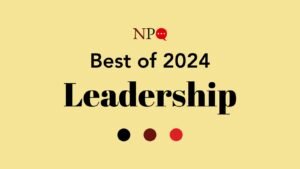
This article is from the Fall/Winter 2011 special edition of the Nonprofit Quarterly, “A New Day Dawning: Contemplating 2012.” It was first published online on December 25, 2011.
There is an important distinction between financial management and financial leadership. Financial management is the collecting of financial data, production of financial reports, and solution of near-term financial issues. Financial leadership, on the other hand, is guiding a nonprofit organization to sustainability. This is the job of an executive director. He or she is responsible for developing and maintaining a business model that produces exceptional mission impact and sustained financial health. To do that successfully, the executive director has to be ever mindful of essential nonprofit business concepts and realities. The following is a guide to this way of thinking for an executive—a summary of what we see as the eight key business principles that should guide financial leadership practice.
1. Activate Your Annual Budget
Strong annual budgeting is an essential element of financial leadership. The best annual budgets align to an annual plan—a written narrative that all staff and board understand about the core activities the organization will undertake in the coming year and how they will be financed. If the budget includes as-yet-unidentified income, which is standard for many organizations, that amount should be clear to all board and staff along with the plan to raise the funds during the year.
Achieve a net financial result. A classic mistake executives make is allowing staff to spend all year on budget when income is not coming in as expected. In fact, it is critical to emphasize to your staff that an annual budget is a plan to reach a net financial result—to yield a specific surplus or to invest a specific amount of the organization’s reserves through a planned deficit. Whichever the financial goal for the year, if the organization is not running on pace to achieve that net financial result, then even budgeted expenses should be questioned and reconsidered. The budget is never permission to spend when income is not coming in as planned.
Anticipate the future. Given that many organizations raise funds and encounter new risks and opportunities throughout the fiscal year, it is important not to stay overly focused on budget variance analysis to the exclusion of rolling analysis of your anticipated financial position. Budget variance is the difference between budgeted and actual results for a given period. While it is useful to understand why predictions were off, it is just as important to be actively anticipating the future. We see too many executives and boards focused on “hitting the budget” rather than anticipating and intentionally shaping their financial futures beyond the current fiscal year. Fiscal years are arbitrary units of time; in reality, the decisions we make—and the consequences of deferred decisions—live on well beyond the fiscal year. For this reason, we recommend that organizations build the habit of rolling financial projection.
Commit to financial projection. At least quarterly, the management team should evaluate what they are learning about current and possible revenue streams, shifts in programming, and strategic opportunities, and there should be a means to capture that up-to-the moment thinking in a financial projection. Midway through the fiscal year, we recommend adding a projection column to the income statement, so that for the rest of the year it includes year-to-date actuals, year-to-date budget, and a column for management’s current projection of where the organization is likely to end the year. Even better, the projection can roll into the “fifth quarter”—that is, across the arbitrary finish line of the fiscal year and into the first quarter of next year.
2. Income Diversification…or Not
Income diversification is often touted as a tenet of sustainability—the idea being that having all of your eggs in one basket is by definition riskier than having them in multiple baskets—or in this case, multiple revenue streams. In fact, nonprofit business models vary considerably by field or service type.
Determine the degree of diversification you need. Income diversification is more possible and more necessary in some models than in others. For instance, community mental health services are likely to be heavily government funded, and once a nonprofit has established a successful track record of providing these services, that government funding may remain in place for years. Even though the organization is technically dependent on one set of government contracts, it may not be in a riskier position than another kind of nonprofit struggling to raise small amounts of money from individuals, corporations, and foundations, for instance. The reliability and competitiveness of your revenue streams dictate the degree of diversification that you need.
Determine risk. Income diversification carries some real risks. Evidence shows that more revenue streams don’t necessarily mean greater annual surpluses or organizational scale. To attract new revenue streams, an organization has to develop and sustain new capacities. As nonprofit finance expert Clara Miller has noted, “Maintaining multiple, highly diverse revenue streams can be problematic when each requires, in essence, a separate business. Each calls for specific skills, market connections, capital investment, and management capacity. Only then will each product attract reliable operating revenue, pay the full cost of operations, and deliver results.”1 And a recent analysis of high-growth nonprofits by the consulting firm Bridgespan Group found that 90 percent had a single, dominant source of funding. Bridgespan concluded that organizations get to scale by specializing in a certain type of funding, and that diversification, and thus risk management, happens by “securing multiple payers of the same type to support their work.”2
3. Make Cash Flow Your Priority
Most financial reports are historical documents, useful to verify what has already happened and compare to budgets and plans.
Develop a cash flow projection. For looking forward, one of the most important tools is a cash flow projection. Executive directors need to know how the organization’s cash flows, and what to do if the cash doesn’t flow. Unless your organization has built up a substantial base of operating cash, any nonprofit can run into cash flow problems. What causes them? A variety of factors, including seasonal fundraising, annual grant payments, reimbursement-based contracts, and start-up costs for new programs.
Anticipate—and resolve—cash flow issues. Cash flow projections require knowledge and judgment that the accounting department may not have. Because of this, executive directors need to have a direct role in developing useful cash flow projections, agreeing on the assumptions to use, and reviewing the projections carefully. The earlier you anticipate cash flow issues, the easier it is to address them. As a first step, assess whether the cash flow shortfall is a problem with timing or is an indication of a deficit. The strategies used to solve the cash flow problem should match the cause of the shortfall.
Manage your shortfalls. Timing problems can be prevented by managing the timing of payments and receipts, improving internal systems, or arranging for a line of credit. Shortfalls caused by deficits need to be solved by budget adjustments or strategic choices to absorb a near-term shortfall. All of these options need the input and support of senior management. Managing cash flow is not a one-time activity. Insist that projecting and discussing cash flow every month or quarter become routine practice.
4. Don’t Wish for Reserves—Plan Them
“Building a reserve” is on the top of the financial wish list of just about every executive director. It’s an understandable goal—just read the preceding section about cash flow and you’ll understand why. Having a cushion of cash that can absorb an unexpected delay in receiving funds, a shortfall in revenue for a special event, or unbudgeted expenses can stabilize an organization. Nonprofits that have built up a good cash cushion have had options and opportunities during the recession that have allowed them to respond to reduced income and increased demand more strategically and carefully than those organizations with few extra dollars in the bank.
Achieve a surplus. Wishing you had reserves is not the same as planning for reserves. But where do reserves come from? For most nonprofits, reserves are built up over time by generating unrestricted surpluses and intentionally designating a portion of the excess cash as a reserve fund. On rare occasions a nonprofit will receive a grant to create an operating reserve fund. So step one in planning for reserves is to develop realistic income and expense budgets that are likely to result in a surplus. Step two is to make sure that achieving a surplus is a priority that is understood and supported by staff and board members. For some organizations, there is an earlier step, too. They have to stop operating with deficits before they can even dream of having a reserve.
Determine your reserve goal. How much should you have? While there are some rules of thumb, generic target amounts don’t take some important variables into account, such as the stability of ongoing cash receipts. A commonly used reserve goal is three to six months’ expenses. At the low end, reserves should be enough to cover at least one payroll, including taxes.
Manage your cushion. Once a nonprofit has been able to build a reserve, using it must be intentional and strategic. Using reserves to fill a long-term income gap is dangerous. A cash cushion allows you to weather serious bumps in the road by buying time to implement new strategies, but reserves should be prudently used to solve temporary problems, not structural financial problems. To maintain reliable reserves, it’s also important to have a realistic plan to replenish them from future surpluses.
Sign up for our free newsletters
Subscribe to NPQ's newsletters to have our top stories delivered directly to your inbox.
By signing up, you agree to our privacy policy and terms of use, and to receive messages from NPQ and our partners.
5. Rethink Restricted Funding
There is an ongoing debate among grantmakers about whether general operating funds are a better investment strategy than programmatically restricted grants. And frustration with funding restrictions is a common refrain among nonprofit executives. But at times this debate gets oversimplified to a notion that all restricted money is bad and inherently compromising of organizational sustainability, when this is not the case. As an executive, what you need to be concerned with is not whether a grant is restricted but what it is restricted to. A restricted grant for a program central to your desired impact and that covers a robust portion of that program’s cost is functionally the same thing as general operating support—it is funding a core piece of the work that you do. The two qualifiers are key, though: you are doing something that the organization would do anyway, and you are getting paid fairly to do it. What you need to avoid is chronic reliance on grants and contracts that pull the organization in unaligned directions or that refuse to pay fairly for the promised outcomes.
Develop effective grant proposals. Your development of sophisticated grant proposals is essential to incorporating restricted funding in your business model effectively. Take a very broad view of any program you are proposing for funding by including as direct costs such elements as hiring program staff, marketing and outreach to clients, staff professional development, and program evaluation. These are the kinds of organizational expenses that directly benefit programs but for which we too rarely charge our investors. If you believe that program evaluation is essential to monitoring effectiveness of outcomes, it’s your obligation to force the issue with funders who classify the cost as “overhead.” Incorporating sophisticated language in your proposal narratives that links staff development to program design to strong program outcomes sets the stage for a budget that includes these critical expenses. Restricted funding from foundations and corporations that genuinely understand and value your organization’s work can be a very sustainable revenue stream if you are very selective about which funders to pursue, and if you pursue them with well-conceived programs and accompanying budgets.
6. Staff Your Finance Function
Put simply, too many executives have not staffed their finance function properly, and they pay the price with chronically underdeveloped financial systems, low-grade financial reporting, and the lack of a trusted partner with whom to do analysis and projection. In Financial Leadership: Guiding Your Organization to Long-Term Success, co-authors Jeanne Bell and Elizabeth Schaffer describe three functional aspects of the finance function: transactional, operational, and strategic. The transactional are the clerical tasks that support the accounting function, such as copying, filing, and making bank deposits; they require someone with excellent attention to detail and exposure to basic accounting principles. The operational are the range of accounting functions, such as paying bills and producing monthly financial statements; they require someone with strong nonprofit accounting knowledge, including managing grants and contracts. And the strategic are the systems development, financial analysis, planning, and communication about the organization’s financial position; they require what we think of as CFO-level knowledge and skills.3
Determine your optimal staffing approach. Every organization needs all three functions, but organizational size and complexity will determine how much time each requires and the optimal staffing approach. In general, it is income that makes nonprofits more or less complex. A $10,000,000 organization that gets all of its money from individual donors requires a very basic accounting system, while a $2,000,000 organization with government contracts and restricted foundation grants requires a very robust accounting system. As an executive, you seriously jeopardize your organization’s funding and reputation if you maintain inadequate systems for tracking contract and grant dollars—it’s a true nonnegotiable. If you have these funds in your business model, you should assume that you will need to fund a very experienced, senior finance staff role.
Invest in contract consultants. So how does an organization with limited resources adequately attend to all three finance functions? Increasingly, we are seeing executives pair contract consultants with staff in the finance function. For instance, a small or midsize nonprofit might invest in an excellent full-time staff accountant who can handle the operational functions expertly and provide oversight to an administrative generalist—such as an office manager, who handles the transactional functions during the 50 percent of her workweek that is directed to the accounting function. Then the executive contracts with a CFO-level consultant who spends fifteen hours per month answering any questions the staff accountant may encounter, doing financial analysis for the management team and board finance committee, developing budgets and projections, and so forth. This way, the executive has a strategic financial partner without creating a fixed staffing cost that she can’t afford. Board members, including the treasurer, have a role that is distinct from the staff finance team. The executive needs an uncomplicated relationship to her finance team so that she can direct them in developing the analysis and reporting she needs as the organization’s financial leader.
7. Help Your Board to Help You
Boards have a governing role in assessing and planning an organization’s finances. In too many cases, though, executive directors expect their boards to stay high-level and strategic without equipping them for the role. It is the executive director’s responsibility to provide the board with information that is appropriate to members’ roles and responsibilities.
Design your financial reports thoughtfully. The board is responsible for short- and long-term planning of the organization, and its members must ensure that systems are in place for effectively using resources and guarding against misuse. The board has legal responsibility for financial integrity but board members are not the accountants, so don’t inundate the board with pages of detailed accounting records and then wonder why the board can’t see the “big picture.” Boards need analysis and interpretation more than they need the numbers. There is no one-size-fits-all financial report. Reports must be designed to communicate information specific to the organization’s size, complexity, and program structure in a format that matches the knowledge level and role of board members.
Understand how boards use financial information. The format and content of reports for the board should be determined by their intended purpose. Boards actually use financial information for four distinct purposes: compliance with financial standards, evaluation of effectiveness, planning, and immediate action.
Compliance. Most nonprofits do pretty well with providing the board with financial reports that comply with the board’s legal fiduciary role to know how much the organization has received and expended. Historical financial reports, audits, and 990s are the common reports.
Evaluation. For the board to evaluate how well the organization has used financial resources, different information is needed. Comparisons are needed to measure progress toward goals, assess the financial aspect of programs, and consider financial strategies.
Planning. When the board is engaged in planning to project future needs and changes or to develop budget guidelines, they need a big-picture understanding of the organization’s history and of the external environment and financial drivers.
Taking Action. Sometimes the board needs to make a key financial decision to implement a strategic plan, react to a sudden change, or respond to an opportunity. In order to make a wise but timely decision, the board needs to understand the background and situation and scenarios based on one or two possible actions. And form should follow function: before developing financial reports for the board, ask what type of actions or decisions the board will need to make, and provide them with the right amount of information and analysis in a format that fits the purpose. Don’t ask your board to maintain a top-level focus on strategy while submitting financial reports better suited to the auditors.
8. Manage the Right Risks
To reduce and manage risks, most nonprofits develop policies and procedures for each area of the organization. The facilities manager maintains controls over keys, access, and insurance coverage. The finance director assures appropriate segregation of duties, internal controls, and checks and balances. Program managers compile information and data to run background checks, keep licenses up to date, and maintain required reporting. If we put them all together in a binder, these policies make up the organization’s risk management process.
Assess your organization’s risks holistically. If each area assesses and formulates its own risks, who is responsible for deciding which risks have the most magnitude and impact on the organization? Put another way, if a nonprofit decided that at least one of its policies had to be eliminated for some reason, how would you decide which one the organization could do without? For example, which of these possible events pose the greatest risk to the organization’s ability to achieve its mission, programmatic, and financial goals: theft of a laptop computer, loss of confidential client data on that computer, or damage to the organization’s reputation if client data were made public?
Consider enterprise risk management. Many nonprofits do a better job of managing the risk of a small theft than they do of identifying and reducing these other two, much greater, risks. Enterprise risk management (ERM) is a term that your auditors may have brought up recently. ERM is essentially the process of assessing all of the risks that the organization faces with a comprehensive, enterprise-wide view and making decisions about managing risk in the same way. An ERM process considers both risks that are evident today and those that are will emerge as operational and strategic plans are implemented. Some organizations need to complete a formal, extensive internal assessment with a staff team and outside consultants. Smaller organizations can complete their own organization-wide review of risks through brainstorming and discussions. The most important step is to start thinking about all the parts as a whole. In the case of the stolen laptop, for example, too much emphasis on limiting access to the office on weekends might have led a program staff member to store confidential data to take home to complete a needed report. Balanced together, these risks would probably have been managed differently than if looked at separately. With the big-picture view of the organization always in mind, the executive director is the right person to advocate ERM by asking members of his or her team to think beyond their own area to the wider enterprise.
…
What’s old is new again. These principles are both longstanding practices and emerging trends for nonprofits. Some of these business principles are undoubtedly familiar to you. Others may run counter to what you may believe to be a “best practice.” Executive directors learn that leading a nonprofit requires a constant balancing of current needs, external demands, and long-term vision. Financial leadership is fundamental to the role and cannot be fully delegated. These principles will help executive directors adapt to the demands of the changing environment and maintain the balance needed for mission impact and sustained financial health.
The Executive Director’s Finance Cheat Sheet
A SUMMARY OF THE EIGHT MUST-DO’S FROM THIS ARTICLE…
- Develop your annual budget with a commitment to its net financial result—whether surplus or planned deficit—and then adjust spending during the year if income is not coming in on pace to yield that net result. Then, complement your annual budget with rolling financial projections that incorporate your most current information about probable future financial results.
- Diversify your income cautiously, ensuring you have the capacity to develop and sustain the programmatic and operational requirements of attracting each new resource type well.
- Develop cash flow projections along with the budget and rolling projections so that you can anticipate any cash flow problems well in advance, when you have more options.
- Plan goals for financial reserves based on your typical cash flow cycles and risks and incorporate reserves into all financial plans and policies. Be sure to foster a financial culture for staff and board that promotes the importance of a regular operating profit or surplus.
- Pursue restricted funding from those foundations and corporations that understand and value your organization’s mission and particular strategies for achieving impact. When pursuing restricted funding, develop proposal narratives and accompanying budgets that link staff development to program design to superior outcomes, including all related costs as direct.
- Ensure that your finance function is always properly staffed; if necessary, use a mix of staff and expert contract consultants to achieve this.
- Discuss expectations for financial roles and responsibilities with board leadership to create accountability and information flow that matches the size and life stage of the organization. Make sure to invest time in developing meaningful financial report formats for the board that reinforce organizational strategies and goals and support the board in fulfilling their responsibilities.
- Introduce the concept of enterprise risk management to your team and initiate an internal assessment of a full range of risks.
Notes
- The Chronicle of Philanthropy; Money and Mission; “Shattering the Myth about Diversified Revenue,” blog entry by Clara Miller, September 2, 2010.
- William Foster and Gail Fine [Perreault], “How Nonprofits Get Really Big,” Stanford Social Innovation Review (Spring 2007): 46.
- Jeanne Bell and Elizabeth Schaffer, Financial Leadership: Guiding Your Organization to Long-Term Success (New York: Turner Publishing / Fieldstone Alliance, 2005), 21.












